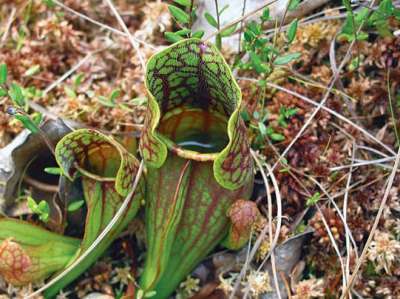When it rains, the cupped leaf of the pitcher plant becomes so slick that ants, spiders, and other prey attracted to its sweet aroma slide into the plant, where they drown and are dissolved by plant enzymes and bacteria. A team of engineers at Harvard University analyzed the pitcher plant and created a patented slippery coating that repels blood, oil, and other liquids from a wide variety of surfaces.
“The surface of the pitcher plant has tiny microstructures that help to trap fluid on it,” explained Tak-Sing Wong, a postdoctoral fellow at the Harvard University School of Engineering and Applied Sciences. “This thin water film acts as a lubricant, so when insects walk on the slippery surface, they can’t grab on and they fall into the plant’s stomach.”
“The effect is similar to when a car hydroplanes, the tires literally glide on the water rather than on the road,” Wong said. “In the case of the ants, the oil on the bottom of their feet will not stick to the slippery coating on the plant. It’s like oil floating on the surface of a puddle.”
Inspired by the plant, Wong and several colleagues designed a strategy for creating slippery surfaces by infusing a synthetic porous material, containing microstructures with a lubricating fluid. The scientists call their product SLIPS: Slippery Liquid-Infused Porous Surfaces.
According to Wong, some liquids have a chemical affinity to particular materials, which makes them adhere better. The researchers created SLIPS by identifying a lubricant with strong carbon-fluorine bonds that has an affinity for a Teflon-like material.
The new product repels a wide variety of liquids and solids. Wong anticipates that the coating could be used on the inside of oil or water pipelines to speed the transport of their contents and in medical tubing, like catheters and blood transfusion systems, to reduce drag. Other potential applications include selfcleaning windows and surfaces that resist bacteria and other types of fouling, like that which forms on ship hulls.
The nearly frictionless surface of the product persists under extreme conditions, including high pressure, humidity, and cold temperatures. Its ability to repel ice may make it useful on refrigerant coils in freezers, air conditioners, and related equipment.
“The versatility of SLIPS, its robustness, and its unique ability to self-heal make it possible to design these surfaces for use almost anywhere,” said Joanna Aizenberg, Harvard professor of materials science and co-author with Wong of a paper describing the technology in the journal Nature. “It potentially opens up applications in harsh environments, such as polar or deep sea exploration, where no satisfactory solutions exist at present.”


